
|   |

|   |
 e-mail: leelakaverivenkat@gmail.com Natya Vriksha's riveting salutation to dance matters Photos courtesy: Natya Vriksha May 10, 2017 Thoughtfully planned, each year's festival mounted by Natya Vriksha in association with the IIC, to celebrate World Dance Day, has had something original to offer. This year's two-day event began with well known critic and arts columnist Shanta Serbjeet Singh being conferred the first Natya Vriksha Lifetime Achievement Award for the many years of contribution to dance writing. 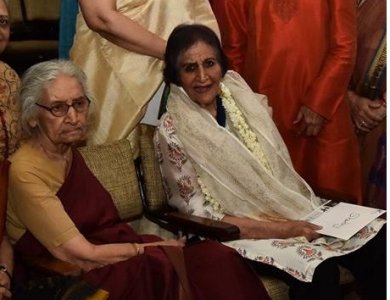 Kapila Vatsyayan with Shanta Serbjeet Singh 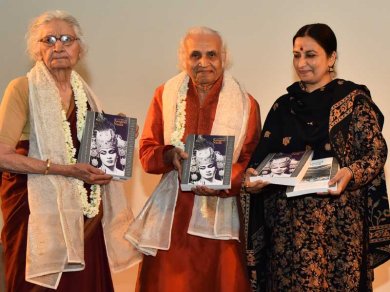 Kapila Vatsyayan, Sunil Kothari, Rita Swamy Chaudhury (Photo: Sarabjit Dhillon) Sunil Kothari, as Kapilaji left early for another appointment, with historic photographs from his collection, recollected his early journey into dance writing - and what with his meeting with great people like Joseph Campbell, veteran dancers like Ramgopal, Indian gurus, western figures like Rudolf Nureyev, and aspects like his being tutored in the social mores by the oldest Jhaveri sister, his closeness to people like Kamaladevi, his meeting with Rukmini Devi, his lec/dem sessions arranged for the Mumbai public, his Bharatanatyam learning under Kalyanasundaram Pillai et al. - it was a most nostalgic peep into budding dance activity of those days. 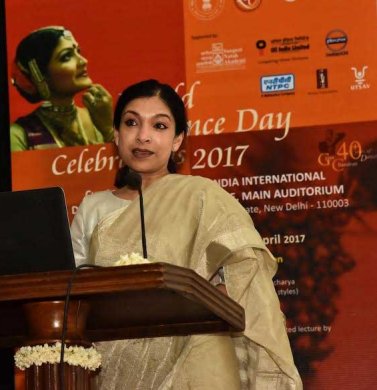 Dr. Sheela Nambiar Also very pertinent was the talk by Dr. Sheela Nambiar on lifestyle for preserving the body of a dancer with all the wear and tear. How to correct muscle imbalances, to increase body stamina and endurance, to develop 'body intelligence' by knowing your body thoroughly, and how to practise with weights to keep the body fit with less fat and more muscle, without gaining weight and how to ensure all round physical, social, emotional well being, hers was a very rounded talk. The number of queries after the lecture showed how very significant the topic was. 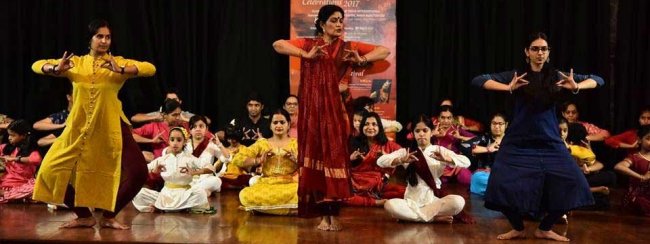 Bharatanatyam workshop with Geeta Chandran 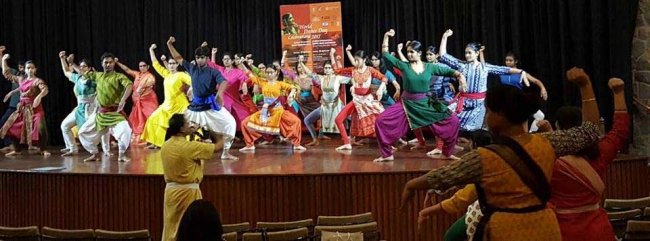 Chhau workshop with Sashadhar Acharya As for the two workshops, one in Bharatanatyam led by Geeta Chandran and the other in Chhau presided over by Seraikella Guru Sashadhar Acharya lured more participants than the modest space of the IIC could accommodate. It proved that dance ultimately has to be a source of joy for the participants. Aniruddha Knight, Bala's grandson, since one last saw him, has evolved a great deal and watching his dance is a different experience from what one usually gets seeing Bharatanatyam recitals as presented today. Right from the Khanda Alaripu start, the musical accompaniment with the backdrop of Usha Shivakumar's vocal support in Dhanyasi ragam, and mridangam by Aniruddha's father Douglas Knight, with nattuvangam by K.P. Rakesh and flute by senior Delhi based artiste T.R. Moorthy, one saw the different approach. In the absence of any embroidered singing, the sustained tempo demanded repetition of lines requiring tremendous breath control. One noticed the uniquely minimalistic way mridangam was played and the cymbals were handled by the nattuvangam specialist - every aspect characterised by a restraint and absence of hype - very different from what dancers have now from the musicians. Teermanams were short and crisp with sollus put together in a subtle arithmetic where foot contact and tala beat did not coincide in an obvious way. Holding himself well, Aniruddha's tall frame never seemed to strike anyone and even while the conditioned eyes and minds in some of the audience missed the geometry of nritta lines made so much a part of the Bharatanatyam performance today (the dancer's defined araimandi apart, the sarukkai-s did not have the full leg stretches seen today), the majority in the auditorium was taken up with the way the dancer projected himself and the abhinaya entirely based on manodharma and improvisation. The Bhairavi varnam centrepiece "Mohamana en meedu" in the musical lines like "Naagareegamaana tirunagaril..." and "Bhoga Tyagesa anubhogam seyya vaa" expressing in one the nayika as devotee, from down below longingly aspiring for the pinnacle comprising the Lord in his temple abode far above, and in the other the erotic feelings of the nayika exhorting the Lord to experience her total surrender to him - both portrayed unselfconsciously and very convincingly. The varnam started off at a fair clip and the accentuated speed in the charanam wherein the elaborations of how Manmatha in hiding was making her the prey for his flowered darts (maaran kanaigal) came out strongly. Also adding to the evocative note was the singing taking on a higher pitch in (Kuyilgal koorude) the cuckoo's songs seeming to exacerbate the unrequited love pangs of the nayika. After Kuvalayashiro in Gaulipantu, it was "Krishna nee begane baro" of Bala fame which impressed. Right through it was the "neelavarnane naatya aaduva" child the mother was endearingly calling out to till the last "thayige bayalli Jagavanne toride" when stunned by the image of the "Jagadhodharana Krishna" in her little son's open mouth, Yashoda thinks in awe of the creator of the universe who saved Draupadi's honour and compares this with what she knew and yearned for - the naughty little child Krishna she rears as her son. The emotive message in Aniruddha's presentation was understood by one and all. 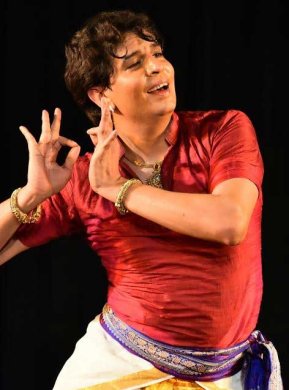 Aniruddha Knight 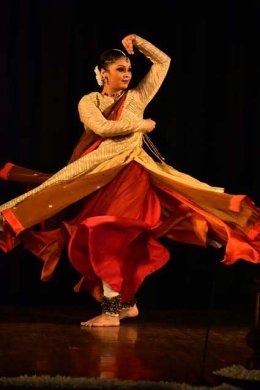 Gauri Diwakar Gauri Diwakar, one of the fast rising Kathak dancers of today, with her fine stage presence, polished lines and nritta, is a delightful dancer to watch. Making an entrance draped in Sandhya Raman's aesthetically designed layered costume which sat well on Gowri's form - except for the white pyjamas which spoilt the entire effect clashing with the colour scheme when she took her chakkars, Gauri began with an invocation to Shiva, Parvati and Ganesha, the Ganesha part predominantly rendered in the seated position, till the hymn to Shiva saw the dancer standing showing iconographic details of Shiva and a gath expressing his swallowing the Halahal poison (choreography by the dancer's mentor Aditi Mangaldas). The melodic accompaniment was based on music sung by Ashwini Bhide Deshpande for Music Today. The dancer went on to her own choreography of Mugdha, a celebration of beauty of womanhood. The title which specifies a particular type of nayika yet unawakened to sringar fulfilment, leads to a certain confusion - for here it is Radha symbolising sringar in full bloom being portrayed. What one missed were the soft touches in tone of both nritta and abhinaya, without which sringar begins to acquire a strident note. Working with Aditi Mangaldas has certainly given Gauri's dance a bodily finish with rhythmic clarity and confidence. But ultimately she must strive to find herself in the dance and not become a carbon copy of her mentor. Her soliloquising dialogue went unheard with the too loud though melodic flute. In the finale Resonance, presenting excerpts from Gauri's production Hari Ho Gati Meri, based on poetry of Sayyad Fazul Hasan also known as Maulana Hasrat Mohani, where Krishna's flute melody becomes the metaphor of the eternal and of ever evolving inner knowledge, "Har nagma Krishna bansuri ka," the gat chals were refined and it was nice to see Kathak intra-forms in both items being brought into play in different contexts. But here again, the feel of ever increasing internalised quietude could be pursued more strongly. The mercifully subdued decibel levels of tabla/pakhawaj interaction of Yogesh Gangani and Ashish Gangani added to the recital. Seldom does one come across a solo Manipuri dancer like Nandita Devi holding the audience enthralled with the electrifying quality of the dance and one wonders why a strong talented dancer like this does not get more performance opportunities. One congratulates Natya Vriksha for selecting her. Thanks to SNA's support in procuring the team of musicians from Manipur, without which the recital could not have been held. While Hanglem Indu Devi's soprano voice filled the auditorium with its emotive throb, the two Pung artists Ningombab Joy Singh and Yanglem Inaocha Singh, with the biting clarity and excellence of their drumming raised the level of the performance. The other competent accompanist was flautist Ibohanbiu Singh. The Gita Govinda ashtapadis began with the verses in the start "Yadi harismarane sarasam mano yadi vilasakalasu kutoohalam madhuralkomal kanti padavali srunu sada Jayadevasaraswateem." When the Padavali "Lalita Lavangalata" followed set to Tanchep, Chari and Teental, it portrayed Radha as virahotkanthita looking desolately at the fullness of Nature in Spring, because Hari is rejoicing dancing with many women, while she bemoans her solitary state. In between the verse passages, short breezy nritta interludes provided rhythmic diversion, while heightening the impact of the interpretative part by contrast. In the next Padavali "Dheera sameere Yamuna teere" it was the sakhi describing to Radha how Krishna suffered in her desertion. After the Tarana, Kaliyadaman portraying Krishna overpowering the serpent Kaliya, again saw the dancer's strong communicating abilities. 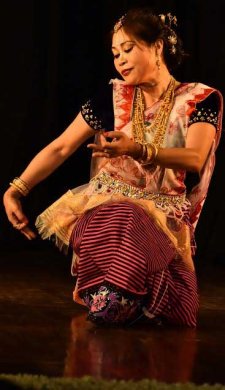 Nandita Devi 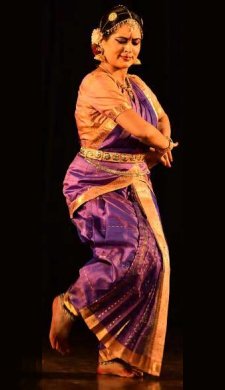 Purva Dhanashree Providing the ideal finish for a painstakingly mounted two day event, was Purva Dhanashree's Vilasini Natyam performance. Starting with a Choornika followed by a Sabda Pallavi (chosen by the dancer's mother Kamalini Dutt) set to raga Manirangu and adi tala, the dancer went on to the heart of the recital - viz. a varnam in Kalyani set to tisra eka talam (the research for which was by the vocalist Venkateshwaran with the rhythmic passages contributed by mridangist Sriganesh. In this composition dedicated to the Soundarya Gopalaswami of Dakshina Dwaraka, viz. Krishna, Purva showed that her Vilasini Natyam training for so many years under Swapnasundari who worked hard with Arudra to resurrect the tradition, had not been in vain. That she is a feather in the guru's cap could be seen from the maturity of her choreography for the varnam wherein her sringar depiction describing the lotus eyed Krishna (sarasijakshulu neeveni) (the dweller of Dakshina Dwarka, the over-powering desire for whom has brought her seeking him (Ninnu chera vacciti raa na swami). He is the patron of all arts and the charanam refrain calls out to the Lord of all learning and knowledge (Gyana vidya loludaina enta nu ra) the abhinaya elaborations spun round each sentence and the impeccable technique she has inherited from the guru for nritta, showed her as a complete dancer. And providing a most inspirational musical base were vocalist Venkateshwaran in crying form, with Chandrakant's nattuvangam, Sriganesh on mridangam, Raghavendra Prakash on violin and Anirudha Bhardwaj on flute, the combined support speaking of well rehearsed effort. Sadashiva Brahmendra's Bruhimukundeti which late M.S. Subbulakshmi made so famous, as a conclusion provided the perfect ending note.  Writing on the dance scene for the last forty years, Leela Venkataraman's incisive comments on performances of all dance forms, participation in dance discussions both in India and abroad, and as a regular contributor to Hindu Friday Review, journals like Sruti and Nartanam, makes her voice respected for its balanced critiquing. She is the author of several books like Indian Classical dance: Tradition in Transition, Classical Dance in India and Indian Classical dance: The Renaissance and Beyond. Post your comments Please provide your name and email id when you use the Anonymous profile in the blog to post a comment. All appropriate comments posted with name & email id in the blog will also be featured in the site. |